Single-hook methods:
1. Folding the twisted yarn
Doubtless the lowest cost way to make a 4-ply cord is to use a Single-hook on an electric or hand drill. 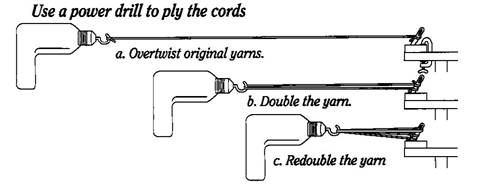 Tighten a sturdy hook into the chuck of the drill. Attach two very long strands to the hook and tie the other end of the strands to a stationary point. Use the drill to twist a long ply to the proper initial over-twist. Then, under tension, fold the long plied strands in half, and then in half again. Attach the ends to the drill's hook and the stationary point as before. Reverse the drill to create a counter-twist. See Peter Collingwood references in the Resources section below for more detail.
Tighten a sturdy hook into the chuck of the drill. Attach two very long strands to the hook and tie the other end of the strands to a stationary point. Use the drill to twist a long ply to the proper initial over-twist. Then, under tension, fold the long plied strands in half, and then in half again. Attach the ends to the drill's hook and the stationary point as before. Reverse the drill to create a counter-twist. See Peter Collingwood references in the Resources section below for more detail.
The folding method is simple in principle, but very difficult to accomplish since tension must be maintained at all times. A second person as helper may be required. Because the final cord length is ¼ of the initial length of the twisted ply, a very long work space is needed to make with cords long enough for ply-split braiding.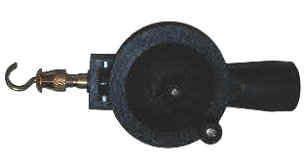
The Spinster Cord Maker available from crafts stores and websites is a low cost combination of hand-drill and hook
2. Using parking-hooks
In her book Ply-split Braiding, Julie Hedges describes a much better way of using a Single-hook twister. 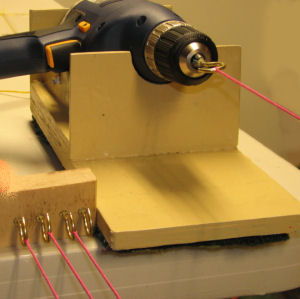 Rather than fold the yarn after the initial over-twist, she twists eac
Rather than fold the yarn after the initial over-twist, she twists eac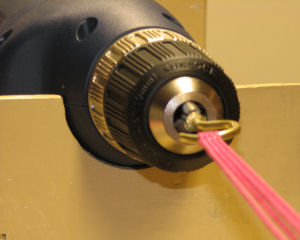 h ply separately. Then she parks the twisted yarn on a hook near the front end of the setup while keeping tension in the twisted ply between the parking hook and the outend. After each ply is twisted, all four plies are placed on the drill hook and counter-twisted.
h ply separately. Then she parks the twisted yarn on a hook near the front end of the setup while keeping tension in the twisted ply between the parking hook and the outend. After each ply is twisted, all four plies are placed on the drill hook and counter-twisted.
The advantage of this is space saving (no folding needed) and labor saving (no helper needed). A single parking-hook will do, but it is better to use four; the outend has four hooks as well. Some degree of care is needed to assure that each ply has the same amount of initial over-twist.
4-hook cord makers:
1. Drill-powered 4-hook cord maker: Bradshaw Cordmaker [Currently unavailable October 2023]
The powered cord making head is designed to be driven by a variable speed electric drill. We have used both cordless and corded drills, but prefer the latter since battery life is an issue with cordless ones. The Bradshaw Cordmaker quickly applies the initial over-twist, and then by releasing the head it does the controlled counter-twist without effort. S-twist or Z-twist is selected by reversing the drill rotation direction. Although the drill-head combination can be used hand-held, we find that use of a simple wooden holder that slides along a table is easier for both measuring the yarn and applying the twist. See Video: Using a Drill-powered 4-hook cord maker and our diagrams at Making Cords with a Powered Cord Maker for a detailed example of its use. Also see Cord Maker Holders for some construction guidance for the holders or sleds.
The Bradshaw Cordmaker is an ideal cord maker for the serious ply-splitter, teachers, and group sharing. It is easy to control the tension and the degree of twist by measuring the take-up shrinkage. It quickly make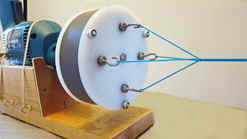 s uniform Z-twist and S-twist cords . Its main detriment is that the operation can be noisy, but this depends on the sound level of your electric drill not the head itself.
s uniform Z-twist and S-twist cords . Its main detriment is that the operation can be noisy, but this depends on the sound level of your electric drill not the head itself.
The Bradshaw is normally operated with a 3/8 inch or larger electric drill a 3/8 inch chuck)
.
2. 4-Ply Lacis Power Cord Maker/Fringe Twister
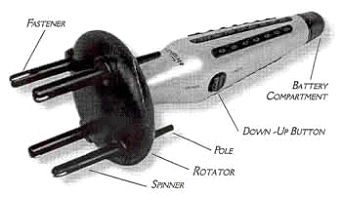 The Lacis Cord Maker/Fringe Twister is a battery operated device that uses two AA batteries for Lacis Fringe Twister power. It is light weight and portable. It is , however, only capable of making Z-twist cords. The battery life is sufficient for making cords for a project or two, but the limitation to Z-twist cords is a serious detriment. There are many ply-split braiding patterns that use only Z-twist cords, but there are also many that need S-twist cords. The hooks are small but adequate for most yarns. Heavy yarn or raffia would require some effort to fit in hooks or a work-around with a string loop.
The Lacis Cord Maker/Fringe Twister is a battery operated device that uses two AA batteries for Lacis Fringe Twister power. It is light weight and portable. It is , however, only capable of making Z-twist cords. The battery life is sufficient for making cords for a project or two, but the limitation to Z-twist cords is a serious detriment. There are many ply-split braiding patterns that use only Z-twist cords, but there are also many that need S-twist cords. The hooks are small but adequate for most yarns. Heavy yarn or raffia would require some effort to fit in hooks or a work-around with a string loop.
This tool is simple to use. Hook the threads on the posts and push the button one direction for the initial over-twist. Then push the button the other direction for the controlled counter-twist to twist the sets of plies together into a 4-ply cord.
Other devices and methods
Fringe twisters
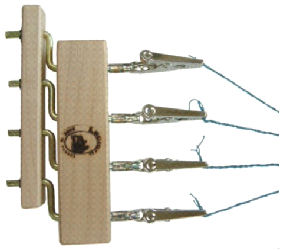 Cords can be made using a hand fringe twisters. This requires one hand twist per cord twist while LeClerc Fringe Twister manually maintaining tension; it lacks the mechanical advantage of the methods discussed above, and thus it is tedious and impractical for the hundreds of twists needed for long tightly-twisted cords. The alligator-clip clamps do not hold the strands well enough for the tensions required. We find these twisters to be unacceptable for making ply-split braiding cords.
Cords can be made using a hand fringe twisters. This requires one hand twist per cord twist while LeClerc Fringe Twister manually maintaining tension; it lacks the mechanical advantage of the methods discussed above, and thus it is tedious and impractical for the hundreds of twists needed for long tightly-twisted cords. The alligator-clip clamps do not hold the strands well enough for the tensions required. We find these twisters to be unacceptable for making ply-split braiding cords.
Spinning Wheels
We have seen reports in online chat rooms of people attempting to make cords for ply-splitting using a spinning wheel. None have, to our knowledge, reported success.
...And more
Schacht Spindle Company's Incredible Rope Machine ($42) has only three hooks. We have seen reports of testing a 4-hook model, but it shares the disadvantages of all the hand fringe twisters, mainly the tediousness of twisting long cords and maintaining good tension.
We do not find any of these hand winding methods acceptable
Resources
Cord making is described in several sources:
- Our own web pages cited above may be helpful. (Cord Making for Ply-Split Braiding)..
- Peter Collingwood's The Techniques of Ply-split Braiding (ISBN 0-9625586-9-9) devotes Chapter 3 to a discussion with detailed drawings of several cord making methods. Peter also describes his Single-hook method in Weavers, which is now available free online.
- The cord making section of Julie Hedges book Ply-split Braiding is very clear about cord making with good illustrations.
- Linda Hendrickson has a video on using the Bradshaw cord maker. Linda also describes a Single-hook method on the her website .
If you still are not quite ready to make you own cords, we offer a variety of colors in 4-ply cotton cords. {click here}
Acknowledgements
Our thanks to Jason Collingwood for permission to use the diagram by the late Peter Collingwood.
M-site
Cord Making, Expanded Information
Ply-Split Braiding gripfids, cords, books.
©All content is copyrighted by Louise French 2007-2023
Contact Louise by e-mail at louise @ louisefrench.com
